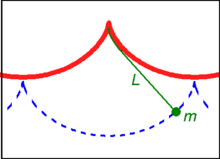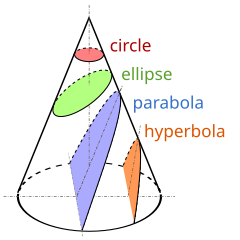ഗണിതവും ഭൗതികശാസ്ത്രവും തമ്മിലുള്ള ബന്ധം
പണ്ടുകാലം മുതൽക്ക് തത്വചിന്തകരും, ഗണിതശാസ്ത്രജ്ഞരും, ഭൗതികശാസ്ത്രജ്ഞരും സമീപകാലത്ത് ചരിത്രകാരന്മാരും വിദ്യാഭ്യാസവിചക്ഷണരും പഠിച്ചുകൊണ്ടിരിക്കുന്ന വിഷയമാണ് ഗണിതവും ഭൗതികശാസ്ത്രവും തമ്മിലുള്ള ബന്ധം.[2] ഇവ തമ്മിൽ അടുത്ത ബന്ധം ഉണ്ടെന്ന് പൊതുവിൽ അംഗീകരിക്കുമ്പോൾ തന്നെ,[3] ഭൗതികശാസ്ത്രത്തിന്റെ "അടിസ്ഥാനപരമായ ഒരു ഉപകരണമായാണ് ഗണിതത്തെ കണക്കാക്കിയിട്ടുള്ളത്"[4] കൂടാതെ, ഭൗതികശാസ്ത്രം ഗണിതശാസ്ത്രത്തിന്റെ "സമ്പന്നമായ പ്രചോദനമായും കണക്കാക്കപ്പെടുന്നു".[5]


അരിസ്റ്റോട്ടിൽ തന്റെ ഫിസിക്സ് എന്ന കൃതിയിൽ കൈകാര്യം ചെയ്ത ഒരു ശീർഷകം ഭൗതികശാസ്ത്രജ്ഞരുടെയും ഗണിതശാസ്ത്രജ്ഞരുടെയും പഠനങ്ങൾ എങ്ങനെ വ്യത്യസ്തമായിരിക്കുന്നു എന്നതാണ്.[6] പ്രകൃതിയുടെ ഭാഷയായി ഗണിതത്തെ കണക്കാക്കുന്ന സമീപനങ്ങൾ പൈതഗോറിയന്മാരുടെ ആശയങ്ങളിൽ കാണാനാകും. പൈതഗോറിയന്മാർ "സംഖ്യകൾ ലോകത്തെ ഭരിക്കുന്നു", "എല്ലാം സംഖ്യകളാണ്",[7][8] എന്നും, രണ്ട് നൂറ്റാണ്ടുകൾക്ക് ശേഷം ഗലീലിയോ ഗലീലി:"പ്രകൃതിയുടെ പുസ്തകം ഗണിതത്തിന്റെ ഭാഷയിലാണ് എഴുതിയിട്ടുള്ളത്" എന്നും പറഞ്ഞിട്ടുണ്ട്.[9][10]
ഗോളത്തിന്റെ വ്യാപ്തം കണ്ടെത്തുന്നതിനുള്ള സൂത്രവാക്യത്തെ സാധൂകരിക്കാനായി ഗണിത തെളിവുകൾക്ക് മുൻപ് ആർക്കിമിഡീസ് ഭൗതിക തെളിവുകളാണ് മുന്നോട്ടുവെച്ചത്.[11] 17ആം നൂറ്റാണ്ട് മുതൽ ഗണിതത്തിലെ പല നേട്ടങ്ങളും ഭൗതികശാസ്ത്ര പഠനത്തിൽ നിന്ന് പ്രചോദനം ഉൾക്കൊണ്ടുകൊണ്ടായിരുന്നു. 19ആം നൂറ്റാണ്ടിന് ശേഷം ഗണിതം കൂടുതൽ കൂടുതൽ സ്വതന്ത്രമായിത്തുടങ്ങിയെങ്കിലും ഭൗതികശാസ്ത്രത്തിന്റെ സ്വാധീനം പിന്നീടും തുടർന്നു.[12][13] കലനത്തിന്റെ(calculus) കണ്ടെത്തലും വളർച്ചയും ഭൗതികശാസ്ത്ര പഠനത്തിന്റെ ആവശ്യങ്ങളോട് ബന്ധപ്പെട്ടായിരുന്നു:[14] ഗലീലിയോ ഗലീലി, ഐസക് ന്യൂട്ടൺ, എന്നിവരുടെ പഠനങ്ങളിലൂടെ ഉരുത്തിരിഞ്ഞ ബലതന്ത്രപരമായ ചലനാത്മകതയെ പഠിക്കാൻ പുതിയ ഒരു ഗണിത ഭാഷ ആവശ്യമായി വന്നു.[15] ഈകാലത്ത്, ഗണിതവും ഭൗതികശാസ്ത്രവും തമ്മിലുള്ള അതിർവരമ്പ് നേരിയതായിരുന്നു;[16] ഉദാഹരണത്തിന് ജ്യാമിതിയെ ബലതന്ത്രത്തിന്റെ ശാഖയായാണ് ന്യൂട്ടൺ കണക്കാക്കിയിരുന്നത്.[17] കാലക്രമേണ കൂടുതൽ കൂടുതൽ പരിഷ്കൃതവും സങ്കീർണവുമായ ഗണിതക്രിയകൾ ഭൗതികശാസ്ത്രത്തിൽ ഉപയോഗിച്ചുതുടങ്ങി. സൂപ്പർ സ്ട്രിങ്ങ് സിദ്ധാന്തത്തിൽ ഉപയോഗിക്കുന്നത് പോലെ കൂടുതൽ കൂടുതൽ സങ്കീർണമായി ഗണിതവിജ്ഞാനമാണ് ഇന്നത്തെ ഭൗതികശാസ്ത്രപഠനത്തിൽ ഉപയോഗിക്കുന്നത്.[18]
തത്ത്വശാസ്ത്ര പ്രശ്നങ്ങൾ
തിരുത്തുകഗണിതത്തിലെ തത്വശാസ്ത്രത്തിൽ പരിഗണിക്കപ്പെടുന്ന ചില പ്രശ്നങ്ങൾ താഴെപ്പറയുന്നവയാണ്:
- ഭൗതികപ്രപഞ്ചത്തിന്റെ പഠനത്തിൽ ഗണിതത്തിന്റെ ഫലപ്രാപ്തി വിവരിക്കുക: "ഈ സന്ദർഭത്തിൽ എല്ലാ കാലത്തും ജിജ്ഞാസുക്കളുടെ ധിഷണയെ പ്രക്ഷുബ്ധമാക്കിയിട്ടുള്ള ഒരു പ്രഹേളിക മുന്നിലെത്തുന്നു. മനുഷ്യ ചിന്തയുടെ ഉല്പന്നമായ, അനുഭവജ്ഞാനത്തിൽ അധിഷ്ഠിതമല്ലാത്ത ഗണിതം യഥാർത്ഥ വിഷയങ്ങളെ കൈകാര്യം ചെയ്യാൻ ശ്ലാഘനീയമാംവിധം സമുചിതമായിരിക്കുന്നതെങ്ങനെയാണ്?" — ആൽബർട്ട് ഐൻസ്റ്റീൻ, ജ്യോമെട്രി ആൻഡ് എക്സ്പീരിയൻസ്(Geometry and Experience 1921).[19]
- ഗണിതത്തെയും ഭൗതികശാസ്ത്രത്തെയും വ്യക്തമായി വേർതിരിക്കുക:ചില ഗവേഷണഫലങ്ങളോ കണ്ടുപിടിത്തങ്ങളോ പരാമർശിക്കുമ്പോൾ ഗണിതമാണോ ഭൗതികശാസ്ത്രമാണോ എന്ന് വേർതിരിക്കാൻ പ്രയാസമാണ്.[20]
- ഭൗതിക പ്രപഞ്ചത്തിന്റെ ജ്യാമിതി എന്താണ്?[21]
- ഗണിതത്തിന്റെ മൗലികതത്വങ്ങളുടെ (axioms) ഉൽഭവം എന്താണ്?[22]
- മുൻപേ നിലവിലുള്ള ഗണിതം പുതിയ ഭൗതിക സിദ്ധാന്തങ്ങളുടെ ഉൽഭവത്തിലും വികാസത്തിലും സ്വാധീനം ചെലുത്തുന്നത് എങ്ങനെയാണ്?[23]
- Is arithmetic a priori or synthetic? (from Kant, see Analytic–synthetic distinction)[24]
- ഭൗതികശാസ്ത്രത്തിലെ ഒരു പരീക്ഷണം നടത്തി അതിന്റെ ഫലം നിരീക്ഷിക്കുന്നതും ഗണിതക്രിയ ചെയ്ത് ഫലം കണ്ടെത്തുന്നതും തമ്മിൽ ഉള്ള അടിസ്ഥാനപരമായ വ്യത്യാസമെന്താണ്? (Turing–Wittgenstein സംവാദത്തിൽ നിന്നും)[25]
- ഗോദലിന്റെ അപൂർണതാ സിദ്ധാന്തം (Gödel's incompleteness theorems ) ഭൗതിക സിദ്ധാന്തങ്ങൾ എപ്പോഴും അപൂർണമായിരുക്കുമെന്ന് സൂചിപ്പിക്കുന്നുണ്ടോ? (from Stephen Hawking)[26][27]
- ഗണിതം ഒരു കണ്ടുപിടിത്തമാണോ കണ്ടെത്തലാണോ (Is math invented or discovered?) (millennium-old question, raised among others by Mario Livio)[28]
വിദ്യാഭ്യാസം
തിരുത്തുകഗണിതവും ഭൗതികശാസ്ത്രവും തമ്മിൽ പരസ്പരബന്ധം ഉണ്ടെങ്കിലും സമീപകാലത്ത് ഈ രണ്ട് വിഷയങ്ങളും പ്രത്യേകമായി പഠിപ്പിച്ചുവരുന്നു.[29] ഗണിത ശാസ്ത്രം പഠിപ്പിക്കുന്നതിൽ തല്പരരായ ഫെലിക്സ് ക്ലെയ്ൻ, റിച്ചാർഡ് കോറന്റ്, ഫ്ലാഡിമിർ ആർനോൾഡ്, മോറിസ് ക്ലെയ്ൻ തുടങ്ങിയ ഗണിതശാസ്ത്രജ്ഞർ ഭൗതികശാസ്ത്രവുമായി ബന്ധപ്പെടുത്തി ഗണിതം പഠിപ്പിക്കണമെന്ന് അഭിപ്രായപ്പെടുന്നുണ്ട്.[30][31]
ഇതു കൂടി കാണുക
തിരുത്തുകഅവലംബങ്ങൾ
തിരുത്തുക- ↑ Jed Z. Buchwald; Robert Fox (10 October 2013). The Oxford Handbook of the History of Physics. OUP Oxford. p. 128. ISBN 978-0-19-151019-9.
- ↑ Uhden, Olaf; Karam, Ricardo; Pietrocola, Maurício; Pospiech, Gesche (20 October 2011). "Modelling Mathematical Reasoning in Physics Education". Science & Education. 21 (4): 485–506. Bibcode:2012Sc&Ed..21..485U. doi:10.1007/s11191-011-9396-6.
- ↑ Francis Bailly; Giuseppe Longo (2011). Mathematics and the Natural Sciences: The Physical Singularity of Life. World Scientific. p. 149. ISBN 978-1-84816-693-6.
- ↑ Sanjay Moreshwar Wagh; Dilip Abasaheb Deshpande (27 September 2012). Essentials of Physics. PHI Learning Pvt. Ltd. p. 3. ISBN 978-81-203-4642-0.
- ↑ Atiyah, Michael (1990). On the Work of Edward Witten (PDF). International Congress of Mathematicians. Japan. pp. 31–35. Archived from the original (PDF) on 2017-03-01.
- ↑ Lear, Jonathan (1990). Aristotle: the desire to understand (Repr. ed.). Cambridge [u.a.]: Cambridge Univ. Press. p. 232. ISBN 9780521347624.
- ↑ Gerard Assayag; Hans G. Feichtinger; José-Francisco Rodrigues (10 July 2002). Mathematics and Music: A Diderot Mathematical Forum. Springer. p. 216. ISBN 978-3-540-43727-7.
- ↑ Al-Rasasi, Ibrahim (21 June 2004). "All is number" (PDF). King Fahd University of Petroleum and Minerals. Archived from the original (PDF) on 2014-12-28. Retrieved 13 June 2015.
- ↑ Aharon Kantorovich (1 July 1993). Scientific Discovery: Logic and Tinkering. SUNY Press. p. 59. ISBN 978-0-7914-1478-1.
- ↑ Kyle Forinash, William Rumsey, Chris Lang, Galileo's Mathematical Language of Nature Archived 2013-09-27 at the Wayback Machine..
- ↑ Arthur Mazer (26 September 2011). The Ellipse: A Historical and Mathematical Journey. John Wiley & Sons. p. 5. ISBN 978-1-118-21143-4.
- ↑ E. J. Post, A History of Physics as an Exercise in Philosophy, p. 76.
- ↑ Arkady Plotnitsky, Niels Bohr and Complementarity: An Introduction, p. 177.
- ↑ Roger G. Newton (1997). The Truth of Science: Physical Theories and Reality. Harvard University Press. pp. 125–126. ISBN 978-0-674-91092-8.
- ↑ Eoin P. O'Neill (editor), What Did You Do Today, Professor?: Fifteen Illuminating Responses from Trinity College Dublin, p. 62.
- ↑ Timothy Gowers; June Barrow-Green; Imre Leader (18 July 2010). The Princeton Companion to Mathematics. Princeton University Press. p. 7. ISBN 1-4008-3039-7.
- ↑ David E. Rowe (2008). "Euclidean Geometry and Physical Space". The Mathematical Intelligencer. 28 (2): 51–59. doi:10.1007/BF02987157.
- ↑ "String theories". Particle Central. Four Peaks Technologies. Archived from the original on 2020-10-05. Retrieved 13 June 2015.
- ↑ Albert Einstein, Geometry and Experience Archived 2019-10-22 at the Wayback Machine..
- ↑ Pierre Bergé, Des rythmes au chaos.
- ↑ Gary Carl Hatfield (1990). The Natural and the Normative: Theories of Spatial Perception from Kant to Helmholtz. MIT Press. p. 223. ISBN 978-0-262-08086-6.
- ↑ Gila Hanna; Hans Niels Jahnke; Helmut Pulte (4 December 2009). Explanation and Proof in Mathematics: Philosophical and Educational Perspectives. Springer Science & Business Media. pp. 29–30. ISBN 978-1-4419-0576-5.
- ↑ "FQXi Community Trick or Truth: the Mysterious Connection Between Physics and Mathematics". Archived from the original on 2021-12-14. Retrieved 16 April 2015.
- ↑ James Van Cleve Professor of Philosophy Brown University (16 July 1999). Problems from Kant. Oxford University Press, USA. p. 22. ISBN 978-0-19-534701-2.
- ↑ Ludwig Wittgenstein; R. G. Bosanquet; Cora Diamond (15 October 1989). Wittgenstein's Lectures on the Foundations of Mathematics, Cambridge, 1939. University of Chicago Press. p. 96. ISBN 978-0-226-90426-9.
- ↑ Pudlák, Pavel (2013). Logical Foundations of Mathematics and Computational Complexity: A Gentle Introduction. Springer Science & Business Media. p. 659. ISBN 978-3-319-00119-7.
- ↑ Stephen Hawking. "Godel and the End of the Universe"[പ്രവർത്തിക്കാത്ത കണ്ണി]
- ↑ Mario Livio (August 2011). "Why math works?". Scientific American: 80–83.
{{cite journal}}: CS1 maint: year (link) - ↑ Karam; Pospiech; & Pietrocola (2010). "Mathematics in physics lessons: developing structural skills Archived 2017-07-12 at the Wayback Machine."
- ↑ Stakhov "Dirac’s Principle of Mathematical Beauty, Mathematics of Harmony"
- ↑ Richard Lesh; Peter L. Galbraith; Christopher R. Haines; Andrew Hurford (2009). Modeling Students' Mathematical Modeling Competencies: ICTMA 13. Springer. p. 14. ISBN 978-1-4419-0561-1.
കൂടുതൽ വായനയ്ക്ക്
തിരുത്തുക- Arnold, V. I. (1999). "Mathematics and physics: mother and daughter or sisters?". Physics-Uspekhi. 42 (12). Bibcode:1999PhyU...42.1205A. doi:10.1070/pu1999v042n12abeh000673. Retrieved 30 May 2014.
- Arnold, V. I. (1998). "On teaching mathematics". Russian Mathematical Surveys. 53 (1): 229–236. Bibcode:1998RuMaS..53..229A. doi:10.1070/RM1998v053n01ABEH000005. Archived from the original on 2017-04-28. Retrieved 29 May 2014.
- Atiyah, M.; Dijkgraaf, R.; Hitchin, N. (1 February 2010). "Geometry and physics" (PDF). Philosophical Transactions of the Royal Society A: Mathematical, Physical and Engineering Sciences. 368 (1914): 913–926. Bibcode:2010RSPTA.368..913A. doi:10.1098/rsta.2009.0227. PMC 3263806. Retrieved 29 May 2014.
- Boniolo, Giovanni; Budinich, Paolo; Trobok, Majda, eds. (2005). The Role of Mathematics in Physical Sciences: Interdisciplinary and Philosophical Aspects. Dordrecht: Springer. ISBN 9781402031069.
- Colyvan, Mark (2001). "The Miracle of Applied Mathematics" (pdf). Synthese. 127: 265–277. doi:10.1023/A:1010309227321. Retrieved 30 May 2014.
- Dirac, Paul (1938–1939). "The Relation between Mathematics and Physics". Proceedings of the Royal Society of Edinburgh. 59 Part II: 122–129. Retrieved 30 March 2014.
- Feynman, Richard P. (1992). "The Relation of Mathematics to Physics". The Character of Physical Law (Reprint ed.). London: Penguin Books. pp. 35–58. ISBN 978-0140175059.
- Hardy, G. H. (2005). A Mathematician's Apology (PDF) (First electronic ed.). University of Alberta Mathematical Sciences Society. Archived from the original (PDF) on 2021-10-09. Retrieved 30 May 2014.
- Hitchin, Nigel (2007). "Interaction between mathematics and physics". ARBOR Ciencia, Pensamiento y Cultura. 725. Retrieved 31 May 2014.
- Harvey, Alex (2012). "The Reasonable Effectiveness of Mathematics in the Physical Sciences". Relativity and Gravitation, , (). 43 (2011): 3057–3064. arXiv:1212.5854v1. Bibcode:2011GReGr..43.3657H. doi:10.1007/s10714-011-1248-9.
- Neumann, John von (1947). "The Mathematician". Works of the Mind. 1: 180–196. (part 1) (part 2).
- Poincaré, Henri (1907). The Value of Science (PDF). Translated by George Bruce Halsted. New York: The Science Press.
- Schlager, Neil; Lauer, Josh, eds. (2000). "The Intimate Relation between Mathematics and Physics". Science and Its Times: Understanding the Social Significance of Scientific Discovery. Vol. 7: 1950 to Present. Gale Group. pp. 226–229. ISBN 0-7876-3939-7.
- Vafa, Cumrun (2000). "On the Future of Mathematics/Physics Interaction". Mathematics: Frontiers and Perspectives. USA: AMS. pp. 321–328. ISBN 0-8218-2070-2.
-
{{cite conference}}: Empty citation (help) - Eugene Wigner (1960). "The Unreasonable Effectiveness of Mathematics in the Natural Sciences". Communications on Pure and Applied Mathematics. 13: 1–14. Bibcode:1960CPAM...13....1W. doi:10.1002/cpa.3160130102. Archived from the original on 2011-02-28. Retrieved 2018-08-07.